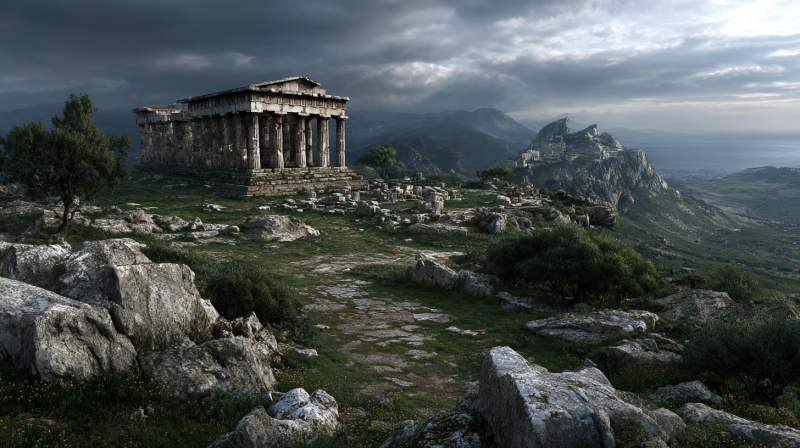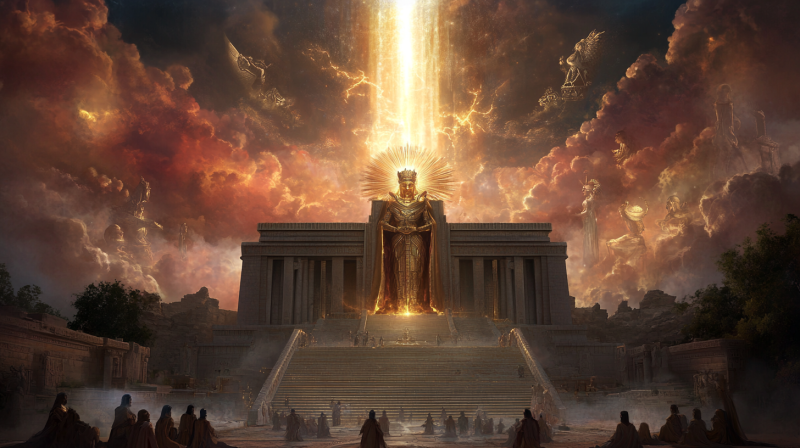In the heart of countless mythologies, there stands a tree—not just any tree, but one whose roots anchor the underworld, whose trunk bridges the realm of mortals, and whose branches cradle the heavens. This is the World Tree, the Axis Mundi, the cosmic pillar that connects all planes of existence. From the frost-rimmed leaves of Yggdrasil in Norse lore to the ceiba tree of the Maya to the expansive cosmic fig tree in Hindu cosmology, this sacred symbol speaks to humanity’s deepest longing to understand its place in the universe.
Let us climb its bark, follow its roots, and see how three ancient civilizations envisioned this arboreal spine of the cosmos.
Yggdrasil – The Norse Tree of Fate
In the frozen mists of Asgard, where gods walk among heroes, there grows a tree vast enough to be seen from every realm. Its name is Yggdrasil, the mighty ash that binds the Nine Worlds of Norse mythology. To the Norse, Yggdrasil was not just a tree—it was the universe.
The Nine Worlds and the Sacred Axis
Each world clings to Yggdrasil’s limbs or coils around its roots:
- Asgard, the realm of the Aesir gods, lies high among its uppermost branches.
- Midgard, the world of men, lies along its central trunk.
- Hel, the shadowed land of the dead, festers among its roots.
Three roots extend in three directions: one to Asgard, another to Jotunheim, the land of giants, and the third to Niflheim, the land of ice and death. Beneath these roots flow sacred wells:
- Urðarbrunnr (Well of Fate), where the Norns, goddesses of destiny, spin the threads of life.
- Mímisbrunnr, the well of wisdom.
- Hvergelmir, the bubbling source of many rivers.
Every day, the gods hold council at the base of Yggdrasil. But this tree is not invincible—it suffers. A dragon, Níðhöggr, gnaws at its roots. An eagle nests in its heights. A squirrel named Ratatoskr scurries up and down, spreading insults between them.
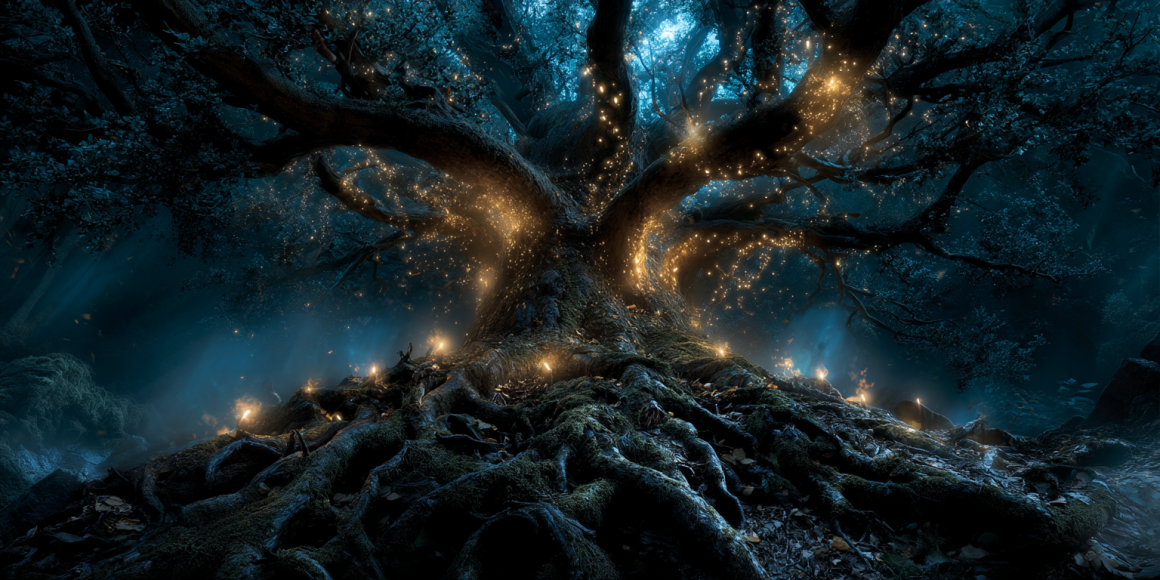
Symbolism and Sacrifice
Odin himself once hung from Yggdrasil for nine nights, pierced by his own spear, seeking the runes—the wisdom of the cosmos. It was an act of self-sacrifice for higher knowledge, a metaphor for enlightenment through suffering. The tree, in this act, becomes not just a map of the universe but a pathway to transformation.
The Ceiba – The Mayan Tree of Life
Thousands of miles away, beneath the canopies of the Mesoamerican jungles, the Maya envisioned a World Tree as a ceiba—tall, straight, with massive roots and branches that reach the skies. The Maya did not carve borders between the divine and the mortal. Their universe was deeply interconnected, and the ceiba was the ultimate axis mundi that held this continuity in place.
The Three Realms of the Universe
In the Maya worldview, the cosmos was a tripartite universe:
- Xibalba, the watery underworld of death and trial, lay beneath.
- The Middleworld, the earthly plane of humans, sprawled across the tree’s trunk.
- The Overworld, a celestial realm of gods and stars, bloomed among its canopy.
The ceiba served as the conduit between these realms. In the Popol Vuh, the sacred book of the Quiché Maya, we read how the Hero Twins descend into the underworld, navigate its deadly trials, and emerge transformed—reborn. It is a narrative echoed in the tree’s symbolism: death, rebirth, and divine passage.
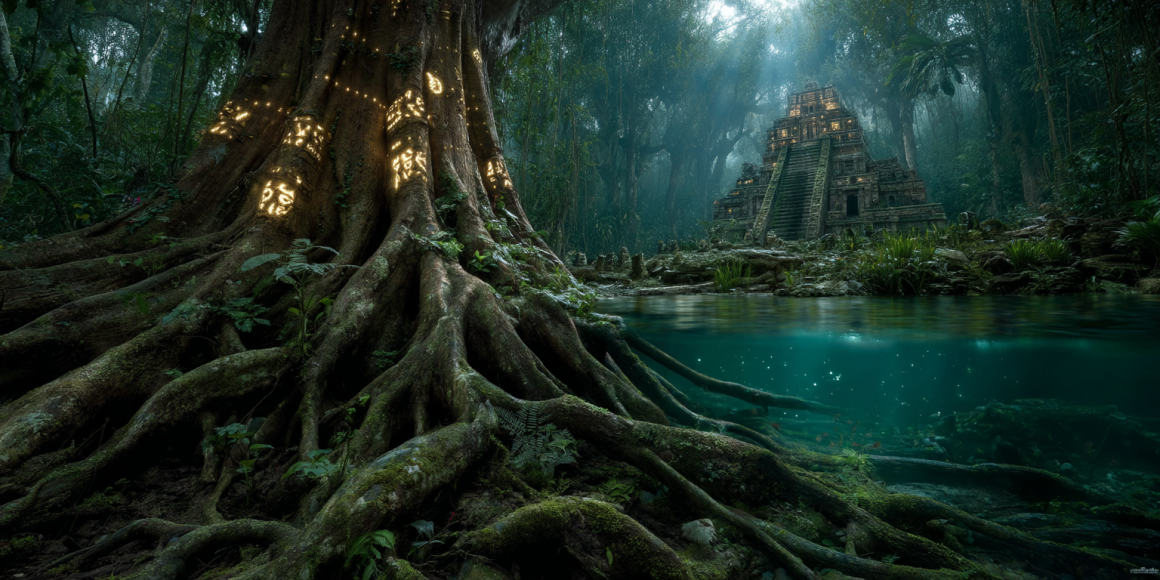
Cardinal Directions and Cosmic Order
The Maya didn’t see just one World Tree—they envisioned four, planted at the corners of the world, marking the cardinal directions, each painted a different color:
- Red for the East
- White for the North
- Black for the West
- Yellow for the South
At the center stood the green tree, the sacred Wacah Chan, connecting all things. In ceremonial plazas, temples were laid out to reflect this cosmological vision, ensuring that even cities followed the blueprint of the universe.
The Ashvattha – Hinduism’s Inverted Cosmic Tree
In the vast philosophical oceans of Hinduism, the World Tree is known as the Ashvattha, or sacred fig tree, and it holds an intriguing twist—it grows upside-down.
Described in the Bhagavad Gita, Chapter 15:
“There is a banyan tree with roots above and branches below, whose leaves are the Vedic hymns. One who knows this tree knows the Vedas.”
Here, the tree’s roots are in the heavens, and its branches extend downward into the material world. This inverted tree is not just a cosmic diagram—it is a spiritual metaphor.
Roots in the Divine, Branches in the Material
The tree represents Samsara, the cycle of birth, death, and rebirth. The branches represent desires and karmic attachments, drawing the soul downward into illusion (maya). To liberate oneself, one must cut the tree with the axe of detachment, seeking union with the Supreme Brahman, the unchanging reality beyond illusion.
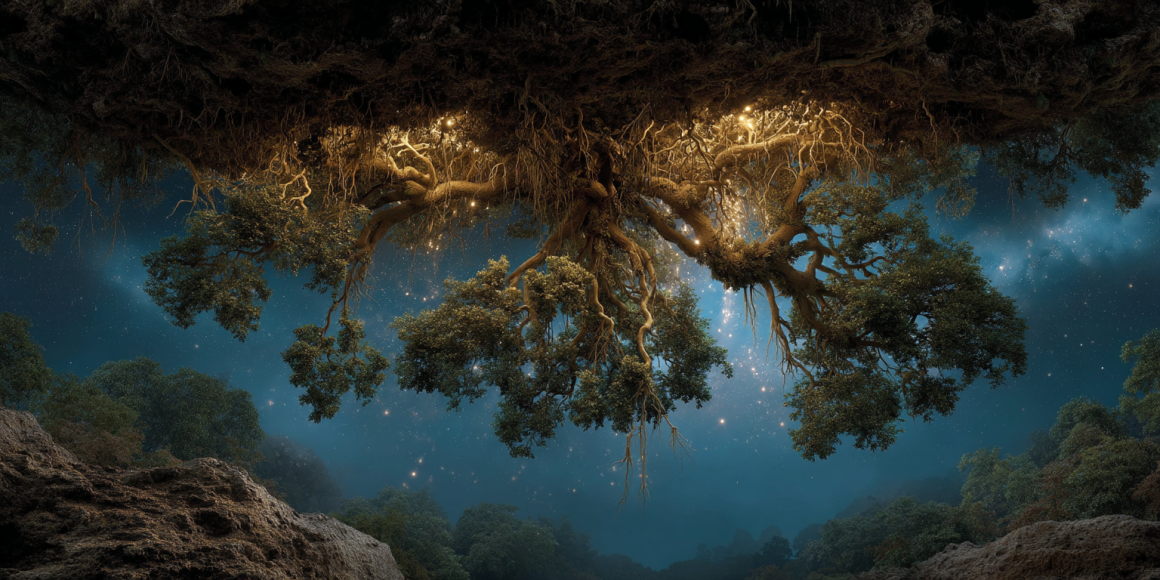
The Tree in Temple and Philosophy
In Hindu temples, trees are often planted as living representatives of the cosmos, especially peepal (fig) trees. Pilgrims circumambulate them in prayer. The Ashvattha is also linked to Vishnu, the sustainer of the universe, and is seen as a manifestation of life’s sacred web.
Its appearance in the Upanishads, Bhagavad Gita, and Puranas shows a long and evolving theological role. Unlike the aggressive battles around Yggdrasil or the underworld voyages of the Maya, Hinduism’s World Tree invites inward reflection—it is less a bridge of motion and more a mirror of the soul’s journey.
Branches Across Time: A Shared Human Vision
What unites these cosmologies across continents and millennia?
- A Tripartite Cosmos – All three systems divide the universe into upper, middle, and lower realms.
- A Central Connector – The tree connects these layers vertically, linking gods, mortals, and ancestors.
- Sacred Geography – Whether it’s the Nine Worlds, the four Mayan directions, or the inverted Ashvattha, sacred space is structured, intentional, and mirrored in temples, myths, and rituals.
- Transformation – These trees are more than symbols; they are pathways. They speak of descent and ascent, of death and rebirth, of illusion and awakening.
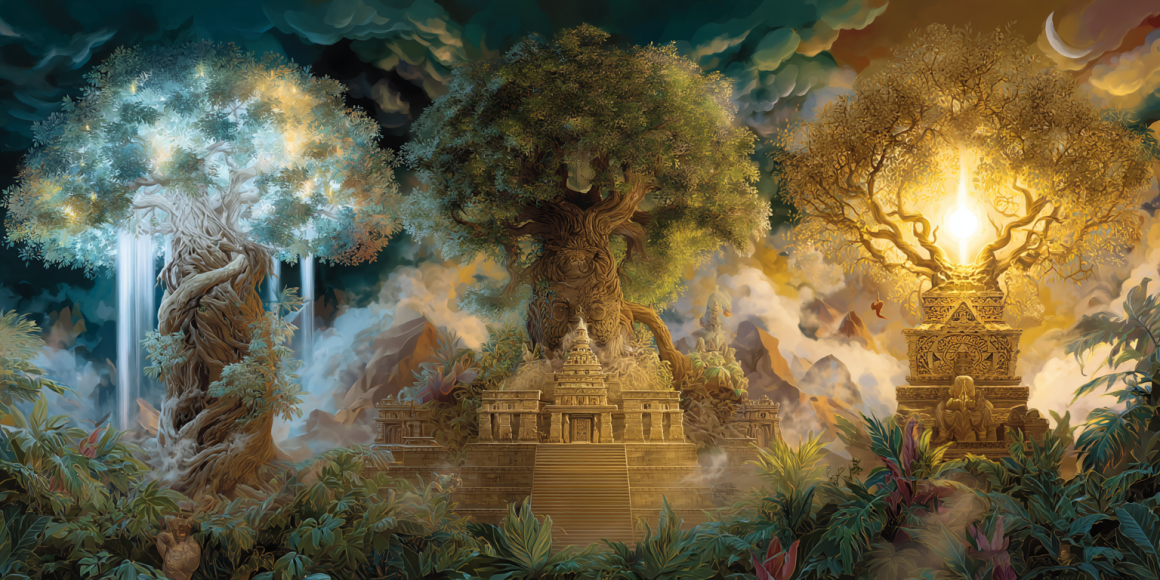
Climbing the Cosmic Tree
From frostbitten Asgard to the steaming jungles of the Yucatán to the meditative ashrams of India, the image of the World Tree rises again and again. It is more than metaphor. It is a blueprint of being, a sacred architecture that reveals how ancient cultures understood life, death, and the divine.
To climb the World Tree is to walk the path of transformation. To sit at its base is to meditate on the mysteries of existence. Whether you call it Yggdrasil, Wacah Chan, or Ashvattha, the World Tree whispers a truth that transcends time:
We are rooted in the eternal.
We bloom through experience.
And if we listen, we might hear the rustle of the sacred wind in our own branches.
Citations
- Davidson, H. R. Ellis. Gods and Myths of Northern Europe. Penguin Books, 1964.
- Stookey, Lorena Laura. Thematic Guide to World Mythology. Greenwood Press, 2004.
- Coe, Michael D. & Houston, Stephen. The Maya. Thames & Hudson, 2015.
- Freidel, David, Linda Schele, and Joy Parker. Maya Cosmos: Three Thousand Years on the Shaman’s Path. Harper Perennial, 1995.
- Sutherland, Sally J. The Bhagavad Gita: A New Translation. Columbia University Press, 1996.
- O’Flaherty, Wendy Doniger. The Upanishads. Penguin Classics, 1996.
- Zimmer, Heinrich. Myths and Symbols in Indian Art and Civilization. Princeton University Press, 1946.

